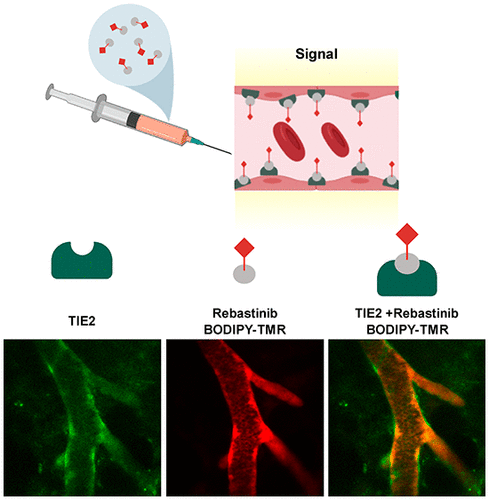当前位置:
X-MOL 学术
›
ACS Chem. Biol.
›
论文详情
Our official English website, www.x-mol.net, welcomes your
feedback! (Note: you will need to create a separate account there.)
Imaging of Tie2 with a Fluorescently Labeled Small Molecule Affinity Ligand.
ACS Chemical Biology ( IF 3.5 ) Pub Date : 2019-12-13 , DOI: 10.1021/acschembio.9b00724 Peter David Koch 1 , Maaz S Ahmed 1 , Rainer H Kohler 1 , Ran Li 1 , Ralph Weissleder 1, 2
ACS Chemical Biology ( IF 3.5 ) Pub Date : 2019-12-13 , DOI: 10.1021/acschembio.9b00724 Peter David Koch 1 , Maaz S Ahmed 1 , Rainer H Kohler 1 , Ran Li 1 , Ralph Weissleder 1, 2
Affiliation

|
The receptor tyrosine kinase inhibitor, Tie2, has significant roles in endothelial signaling and angiogenesis and is relevant in the pathophysiology of several diseases. However, there are relatively few small molecule probes available to study Tie2, making the evaluation of its activity in vivo difficult. Recently, it was discovered that the small molecule rebastinib (DCC-2036) is a potent Tie2 inhibitor. We hypothesized that fluorescent derivatives of rebastinib could be used as imaging agents for Tie2. On the basis of crystallography structures, we synthesized three fluorescent derivatives, which we then evaluated in both in vitro and in vivo assays. We found that the Rebastinib-BODIPY TMR (Reb-TMR) derivative has superior imaging characteristics in vitro, and we successfully labeled endothelial cells in vivo. We propose that this probe could be further used in in vivo applications for studying the role of Tie2 in disease.
中文翻译:

用荧光标记的小分子亲和配体对Tie2进行成像。
受体酪氨酸激酶抑制剂Tie2在内皮信号传导和血管生成中具有重要作用,并且与几种疾病的病理生理学有关。但是,可用于研究Tie2的小分子探针相对较少,因此很难对其体内活性进行评估。最近,发现小分子瑞巴司替尼(DCC-2036)是有效的Tie2抑制剂。我们假设rebastinib的荧光衍生物可以用作Tie2的成像剂。根据晶体结构,我们合成了三种荧光衍生物,然后在体外和体内试验中对其进行了评估。我们发现Rebastinib-BODIPY TMR(Reb-TMR)衍生物在体外具有优越的成像特性,并且在体内成功标记了内皮细胞。
更新日期:2019-12-13
中文翻译:

用荧光标记的小分子亲和配体对Tie2进行成像。
受体酪氨酸激酶抑制剂Tie2在内皮信号传导和血管生成中具有重要作用,并且与几种疾病的病理生理学有关。但是,可用于研究Tie2的小分子探针相对较少,因此很难对其体内活性进行评估。最近,发现小分子瑞巴司替尼(DCC-2036)是有效的Tie2抑制剂。我们假设rebastinib的荧光衍生物可以用作Tie2的成像剂。根据晶体结构,我们合成了三种荧光衍生物,然后在体外和体内试验中对其进行了评估。我们发现Rebastinib-BODIPY TMR(Reb-TMR)衍生物在体外具有优越的成像特性,并且在体内成功标记了内皮细胞。











































 京公网安备 11010802027423号
京公网安备 11010802027423号